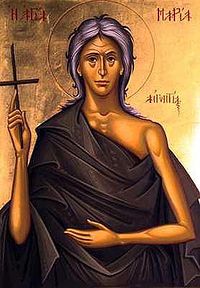In the Name of the Father and of the Son and of the Holy Spirit.
 St. Mary of Egypt
St. Mary of Egypt
Born in Alexandria in Egypt in the middle of the fifth century, as a young girl Mary fell into the vice of prostitution. For seventeen years, from the age of 12 until the age of 29, she lived the life of a harlot. However, once finding herself in Jerusalem, out of curiosity, she went to see the Precious Cross of Christ. She found that she was unable to enter the church where St Helen had placed the Cross, for some invisible force prevented her from entering in. So frightened was she at this that she asked the Mother of God through an icon at the entrance to the church, why this was. The Mother of God replied to her that Mary first needed to repent and obey her. Only after promising to do this was Mary allowed to enter the church in Jerusalem. After then entering and venerating the Cross, Mary heard the Mother of God telling her: 'If you cross the Jordan, you will find true peace'.
So shaken was Mary by these events that she did indeed forsake all her old life and, having taken communion, she crossed the Jordan, and went to live there in the desert. We do not know the exact details of her day-to-day life, but we do know that she dwelt there as a hermitess, eating plants, living in torments and struggle with passionate thoughts, and eventually obtaining the grace to work miracles, crossing the Jordan as if on dry land. She lived naked and became withered and emaciated, as we can see in the icon of her, but nevertheless she survived there for some forty-eight years. Then she was discovered by a pious monk, Zosimas, who is portrayed in the icon together with her. It was to him that she related her life which we have today.
The Life of St Mary teaches us many things. Perhaps the first and most obvious lesson we can learn from her is that we should never judge, never pre-judge. Who will be saved? It is impossible to answer this question, for it is never too late to repent, even for us. Humanly speaking, when we consider the life of Mary until her twenty-ninth year, we might think that salvation had become impossible for her. And yet the service to her calls her 'the greatest of saints'. Humanly speaking, we are condemned; but by the grace of God everything, including the height of repentance, is possible. No man has the right to judge another.
The Life of St Mary of Egypt also teaches us something about human nature. In each of us there is the desire for worldly pleasures, for amusement and entertainment, for food and drink, for the pleasures of the senses. But there is also the desire for pleasures of a higher sort, pleasures that are lasting, which we may call joys. Those joys are so much higher than the fleeting pleasures of the senses that they alone constitute the path to lasting happiness. Societies which are devoted only to the satisfaction of the pleasures of the senses, pleasure-seeking societies, are societies without lasting joys, they are full of sad faces.
The Life of St Mary teaches us that the values of the Church are quite different from those of the world. She went out into the desert and had nothing, no friends, no home, no possessions, no clothes and hardly any food and drink. The world looked for pleasure, the satisfaction of the senses, money and power, but St Mary was moneyless and powerless in the world. Today's Gospel confirms the choice of St Mary, for it says that those who wish to be great must be servants. This is upside down from all the ways of this world. But our Lord preached this and like Him St Mary lived this.
Indeed, as we have already said, the Church calls St Mary 'the greatest of saints'. The use of this word 'great' may surprise. In everyday life, we use 'great' in other meanings. The world speaks of 'great politicians', 'great soldiers', great film-stars', 'great performances by sportsmen', 'a great holiday', 'a great car', 'a great amount of money'. But the Church calls St Mary 'great' and a thousand and a half years after she lived we ask for her prayers, but not for those of any politician or soldier or film-star or sportsman. Let us think more carefully before next we utter this word 'great'.
And as this last week of Great Lent begins, let us also ponder on the words of the Mother of God, which led Mary to her salvation through repentance and her greatness: 'If you cross the Jordan, you will find true peace'. These mysterious words are today also addressed to each of us; the interpretation of their mystery is open to the souls of each of us, but only if we ask the Mother of God and St Mary to guide us. And then we shall find our own 'entry into Jerusalem'.
Holy Mother Mary, pray to God for us!
Amen.
